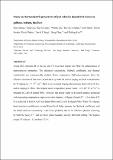Study of the Thermoelectric Properties of Lead Selenide Doped with Boron, Gallium, Indium, or Thallium
Author(s)
Zhang, Qian; Cao, Feng; Lukas, Kevin; Liu, Weishu; Esfarjani, Keivan; Opeil, Cyril; Broido, David; Parker, David; Singh, David J.; Chen, Gang; Ren, Zhifeng; ... Show more Show less
DownloadPaper10_Q. Zhang_JACS.pdf (1.477Mb)
PUBLISHER_POLICY
Publisher Policy
Article is made available in accordance with the publisher's policy and may be subject to US copyright law. Please refer to the publisher's site for terms of use.
Terms of use
Metadata
Show full item recordAbstract
Group IIIA elements (B, Ga, In, and Tl) have been doped into PbSe for enhancement of thermoelectric properties. The electrical conductivity, Seebeck coefficient, and thermal conductivity were systematically studied. Room-temperature Hall measurements showed an effective increase in the electron concentration upon both Ga and In doping and the hole concentration upon Tl doping to ~7 × 10[superscript 19] cm[superscript –3]. No resonant doping phenomenon was observed when PbSe was doped with B, Ga, or In. The highest room-temperature power factor ~2.5 × 10[superscript –3] W m[superscript –1] K[superscript –2] was obtained for PbSe doped with 2 atom % B. However, the power factor in B-doped samples decreased with increasing temperature, opposite to the trend for the other dopants. A figure of merit (ZT) of ~1.2 at ~873 K was achieved in PbSe doped with 0.5 atom % Ga or In. With Tl doping, modification of the band structure around the Fermi level helped to increase the Seebeck coefficient, and the lattice thermal conductivity decreased, probably as a result of effective phonon scattering by both the heavy Tl[superscript 3+] ions and the increased grain boundary density after ball milling. The highest p-type ZT value was ~1.0 at ~723 K.
Date issued
2012-10Department
Massachusetts Institute of Technology. Department of Mechanical EngineeringJournal
Journal of the American Chemical Society
Publisher
American Chemical Society (ACS)
Citation
Zhang, Qian, Feng Cao, Kevin Lukas, Weishu Liu, Keivan Esfarjani, Cyril Opeil, David Broido, et al. “Study of the Thermoelectric Properties of Lead Selenide Doped with Boron, Gallium, Indium, or Thallium.” Journal of the American Chemical Society 134, no. 42 (October 24, 2012): 17731–17738.
Version: Author's final manuscript
ISSN
0002-7863
1520-5126